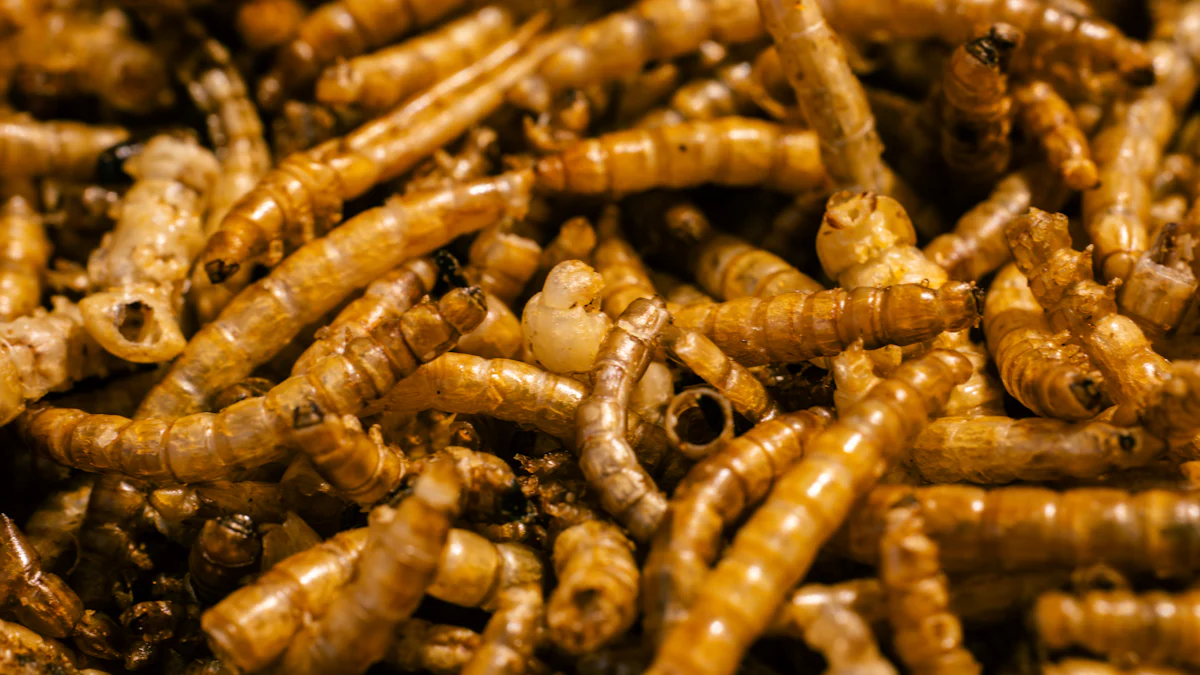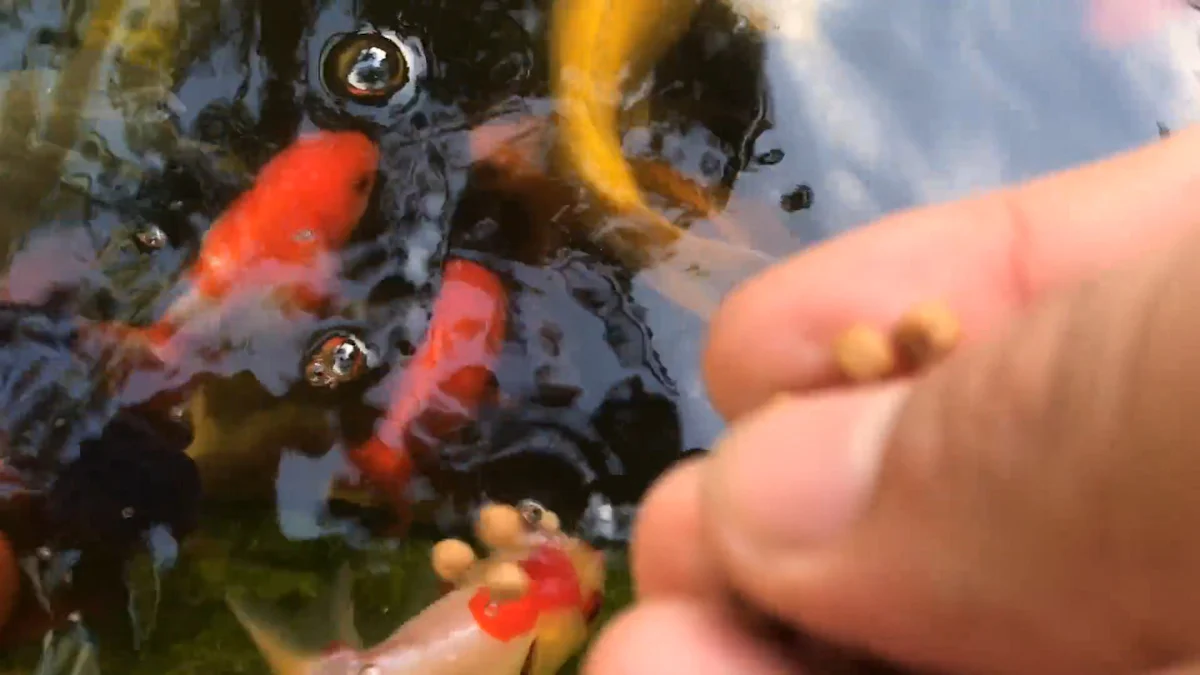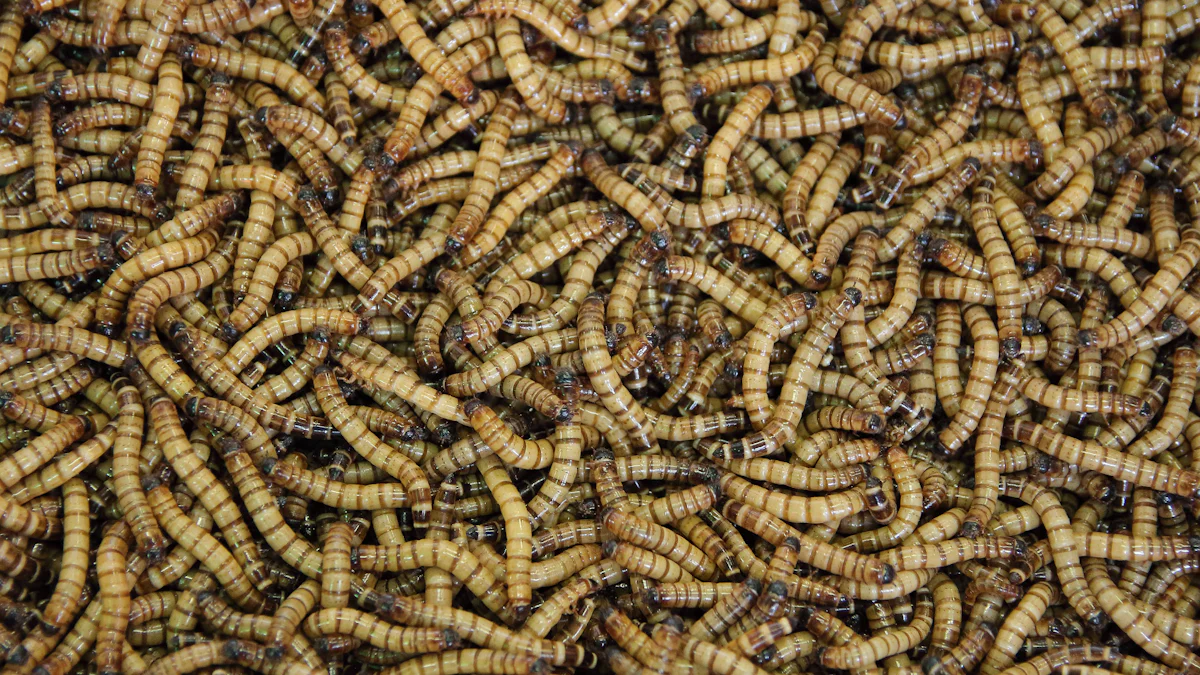
Imagine tropical fish gliding gracefully through vibrant waters, thriving on a natural diet of algae, plankton, and tiny aquatic insects. These colorful creatures rely on a variety of nutrients to maintain their health and beauty. Introducing mealworms into their diet can provide a safe and exciting treat. Packed with protein and healthy fats, mealworms for tropical fish offer a nutrient boost that supports growth and energy. Many species, like cichlids, enjoy the enrichment of insect-based foods, which can even enhance their vivid colors. Proper preparation ensures your fish can safely enjoy this nutritious addition.
Key Takeaways
- Mealworms are a nutritious treat for tropical fish, providing essential protein and healthy fats that support growth and energy.
- Introduce mealworms gradually into your fish’s diet to prevent digestive issues and ensure they adapt comfortably to the new food.
- Both live and dried mealworms have unique benefits; live mealworms offer hydration and enrichment, while dried mealworms are convenient and have a longer shelf life.
- Portion control is crucial—feed mealworms as an occasional treat, about once or twice a week, to avoid obesity and digestive problems.
- Proper preparation, such as cutting mealworms for smaller fish or soaking dried ones, ensures safe and easy consumption.
- Monitor your fish’s behavior and appearance after feeding to determine the right portion sizes and maintain their health.
- Combining mealworms with a varied diet of flakes, pellets, and other foods helps provide balanced nutrition for your tropical fish.
Nutritional Value of Mealworms for Tropical Fish

Mealworms bring a powerhouse of nutrients to the table for your tropical fish. These tiny insects are more than just a snack—they’re a valuable addition to your fish’s diet when used correctly. Let’s dive into what makes mealworms so beneficial and what you should watch out for.
Protein and Fat Content
Mealworms are packed with protein and healthy fats, making them an excellent energy source for tropical fish. Protein plays a vital role in muscle development and overall growth, while fats provide the energy your fish need to stay active and vibrant. Studies have shown that mealworms contain high-quality protein and lipids, which are essential for many fish species. This nutrient combination supports your fish’s health and helps them thrive in their aquatic environment.
Did you know? Mealworms are rich in amino acids and fatty acids, which are crucial for the well-being of cultured finfish species. These nutrients contribute to their overall vitality and resilience.
Benefits for Growth and Energy
Feeding mealworms to your tropical fish can enhance their growth and energy levels. The protein content promotes healthy development, while the fats fuel their daily activities. Many fish, especially cichlids, benefit from the enrichment that insect-based foods like mealworms provide. You might even notice brighter colors and more lively behavior in your fish after introducing mealworms into their diet. This boost in energy and vibrancy can make your aquarium even more captivating.
Mealworms for tropical fish also mimic the natural diet of many species. In the wild, fish often consume insects and other small creatures, so mealworms offer a familiar and nutritious option. By incorporating them into your fish’s meals, you’re providing a diet closer to what they would eat in their natural habitat.
Potential Risks of Overfeeding or Imbalance
While mealworms are nutritious, overfeeding can lead to problems. Their high fat content, if consumed in excess, may cause obesity or digestive issues in your fish. Additionally, relying too heavily on mealworms could create an imbalance in their diet. Tropical fish need a variety of nutrients from different food sources to stay healthy. Mealworms should complement their diet, not replace it.
Dried mealworms, in particular, can be harder for some fish to digest. Cutting them into smaller pieces or soaking them before feeding can help prevent any digestive discomfort. Always monitor how your fish respond to mealworms and adjust portion sizes as needed.
Pro Tip: Introduce mealworms gradually into your fish’s diet. This approach helps their digestive system adapt and reduces the risk of any adverse reactions.
By understanding the nutritional value of mealworms and feeding them responsibly, you can give your tropical fish a tasty treat that supports their health and happiness.
Live vs. Dried Mealworms for Tropical Fish

When deciding between live and dried mealworms for tropical fish, understanding their unique qualities can help you make the best choice for your aquatic pets. Both options offer valuable nutrients, but they differ in texture, preparation, and feeding experience.
Advantages of Live Mealworms
Live mealworms bring a natural and interactive feeding experience to your aquarium. Their movement stimulates your fish’s hunting instincts, making mealtime more engaging. This activity mimics the way fish feed in the wild, where they chase and capture live prey. For species like cichlids, which are known for their love of insects, live mealworms provide both nutrition and enrichment.
Another benefit of live mealworms is their moisture content. They contain natural hydration, which can be especially helpful for fish that thrive on fresh, water-rich foods. Live mealworms are also easy to prepare—simply drop them into the tank and watch your fish enjoy the feast. However, ensure the mealworms are appropriately sized to prevent choking hazards for smaller fish.
Quick Tip: If you’re introducing live mealworms for the first time, start with a small amount to observe how your fish respond.
Benefits of Dried Mealworms
Dried mealworms offer convenience and a longer shelf life, making them a practical choice for busy fish keepers. You don’t need to worry about storing live insects or maintaining their habitat. Dried mealworms are lightweight and easy to portion, allowing you to control feeding amounts with precision.
These mealworms retain their high protein and fat content, providing essential nutrients for your fish. They are an excellent option for medium to large tropical fish, especially if you’re looking for a quick and mess-free feeding solution. Soaking dried mealworms in water before feeding can soften them, making them easier for your fish to digest.
Did you know? Dried mealworms are a great treat for cichlids and other insect-loving fish. Their nutrient density supports growth and energy without the need for live prey.
Drawbacks of Each Option
While both live and dried mealworms have their advantages, they also come with some drawbacks. Live mealworms require proper storage and care to keep them healthy. They can also introduce unwanted bacteria or parasites if not sourced from a reliable supplier. Additionally, some fish may struggle to eat live mealworms due to their size or movement.
Dried mealworms, on the other hand, lack the moisture found in live ones. This can make them harder to digest for certain fish, especially smaller species. Overfeeding dried mealworms may lead to digestive issues or an unbalanced diet. Always monitor your fish’s reaction and adjust feeding practices as needed.
Pro Tip: Combine live and dried mealworms in your fish’s diet to provide variety and balance. This approach ensures your fish enjoy the benefits of both options while minimizing potential risks.
By understanding the differences between live and dried mealworms, you can choose the best option for your tropical fish. Whether you prioritize convenience or enrichment, mealworms for tropical fish can be a nutritious and exciting addition to their diet.
Feeding Tips for Mealworms for Tropical Fish
Feeding mealworms to your tropical fish can be a rewarding experience, but it requires careful planning. By following these tips, you can ensure your fish enjoy the benefits of mealworms without compromising their health.
Portion Sizes and Feeding Frequency
When feeding mealworms to tropical fish, portion control is essential. Overfeeding can lead to health issues like obesity or digestive problems. Start by offering small amounts, especially if your fish are new to this food. A good rule of thumb is to provide mealworms as a treat rather than a staple. For most species, feeding mealworms once or twice a week is sufficient.
Adjust portion sizes based on the size of your fish. Larger fish, like cichlids, can handle whole mealworms, while smaller fish may need them cut into bite-sized pieces. Always observe how much your fish consume within a few minutes. Remove any uneaten mealworms to maintain water quality in the tank.
Quick Tip: Keep track of your fish’s behavior and appearance after feeding mealworms. Healthy, active fish with vibrant colors are signs that you’re feeding the right amount.
Preparation Methods for Different Fish Sizes
Proper preparation ensures mealworms are safe and easy for your fish to eat. For smaller fish, cutting mealworms into tiny pieces makes them more manageable. You can also soak dried mealworms in water to soften them, which helps with digestion. For larger fish, live mealworms can be fed whole, providing both nutrition and enrichment.
If you’re raising your own mealworms, consider feeding them nutrient-rich foods before offering them to your fish. This process, known as gut-loading, boosts the nutritional value of the mealworms. Additionally, freshly molted mealworms (those that have just shed their exoskeleton) are softer and easier to digest, making them an excellent choice for fish of all sizes.
Pro Tip: Always source mealworms from reputable suppliers to avoid introducing harmful bacteria or parasites into your aquarium.
Gradual Introduction to the Diet
Introducing mealworms gradually into your fish’s diet is crucial. Sudden changes in diet can upset their digestive system. Begin by offering a small piece of mealworm alongside their regular food. Observe how your fish react and adjust accordingly.
Over time, you can increase the amount of mealworms as your fish become accustomed to them. This gradual approach minimizes the risk of digestive issues and ensures your fish adapt comfortably to the new food source. Remember, mealworms should complement a balanced diet that includes flakes, pellets, and other live or frozen foods.
Did you know? Many tropical fish, like cichlids, thrive on a varied diet that mimics their natural feeding habits. Adding mealworms to their meals provides enrichment and supports their overall health.
By following these feeding tips, you can safely incorporate mealworms into your tropical fish’s diet. With proper portion sizes, preparation, and a gradual introduction, mealworms can become a nutritious and enjoyable treat for your aquatic pets.
Mealworms for tropical fish can be a fantastic addition to their diet when fed thoughtfully. These nutrient-packed treats provide essential protein and fats that support growth, energy, and overall health. Both live and dried mealworms offer unique benefits, so choose the option that best suits your fish’s needs. Proper preparation, like cutting or soaking, ensures safe consumption and easier digestion. By feeding in moderation and maintaining variety in their diet, you can help your fish thrive. With the right approach, mealworms can enhance your tropical fish’s diet and bring out their vibrant colors and lively behavior.
FAQ
Can you feed mealworms to tropical fish?
Yes, you can feed mealworms to tropical fish. They provide a rich source of protein and healthy fats, making them a nutritious treat. However, you should offer them in moderation and not as the sole food source. To maximize their benefits, gut-load the mealworms with nutrient-rich foods before feeding them to your fish. Always consider the specific dietary needs of your fish species.
Quick Tip: Gut-loading mealworms ensures they deliver optimal nutrition to your fish.
Why should you include mealworms in your fish’s diet?
Mealworms are an excellent addition to your fish’s diet because they mimic the natural diet of many tropical species. They offer high protein content, essential nutrients, and a natural foraging experience. Including mealworms supports your fish’s growth, energy, and overall health. Plus, they add variety to your fish’s meals, which is vital for their well-being.
Did you know? Feeding mealworms also contributes to sustainable food practices, as they are an eco-friendly protein source.
How can mealworms be part of a balanced diet for fish?
Mealworms work best as a supplement to a varied diet. You can feed them freshly molted for easier digestion or combine them with other foods like flakes, pellets, or frozen options. This approach ensures your fish receive a wide range of nutrients. For communal tanks, mealworms are a versatile choice that suits different species.
Pro Tip: Feed mealworms alongside other food sources to maintain a balanced diet for your fish.
Are mealworms nutritious for tropical fish?
Absolutely! Mealworms are packed with protein, fats, and fiber, making them a highly nutritious option. These nutrients support muscle development, energy levels, and overall vitality. For insect-loving fish like cichlids, mealworms are especially beneficial and can even enhance their natural colors.
Fun Fact: Many fish species, including cichlids, thrive on insect-based foods due to their opportunistic eating habits in the wild.
Which fish species can eat mealworms?
Carnivorous and omnivorous fish species, such as cichlids, goldfish, and guppies, can enjoy mealworms. The protein content in mealworms promotes growth and energy, making them ideal for these species. Larger fish can consume whole mealworms, while smaller ones may need them cut into pieces.
Quick Tip: Always match the size of the mealworms to the size of your fish to avoid choking hazards.
Should you choose live or dried mealworms for your fish?
Both live and dried mealworms have their benefits. Live mealworms provide a natural hunting experience and hydration, while dried mealworms are convenient and have a longer shelf life. Your choice depends on your fish’s preferences and your feeding routine. Soaking dried mealworms can make them easier to digest.
Pro Tip: Combine live and dried mealworms to give your fish variety and enrichment.
How often should you feed mealworms to tropical fish?
Feed mealworms as an occasional treat, about once or twice a week. Overfeeding can lead to health issues like obesity or digestive problems. Start with small portions and adjust based on your fish’s size and appetite. Always remove uneaten mealworms to maintain water quality.
Did you know? Observing your fish’s behavior after feeding can help you determine the right portion size.
What is the importance of selecting healthy mealworms?
Healthy mealworms ensure your fish receive the best nutrition. Look for lively, firm-bodied mealworms with a golden-brown color. Avoid those that appear lethargic, discolored, or have an unpleasant odor. Sourcing from reputable suppliers reduces the risk of introducing harmful bacteria or parasites into your tank.
Quick Tip: Freshly molted mealworms are softer and easier for fish to digest, making them a great choice.
Can mealworms improve your fish’s appearance?
Yes, mealworms can enhance your fish’s appearance. The high protein and fat content support vibrant colors and active behavior. Cichlids, in particular, show brighter hues when fed insect-based foods like mealworms. This improvement adds to their aesthetic appeal in your aquarium.
Fun Fact: A varied diet, including mealworms, helps tropical fish mimic their natural feeding habits, boosting their overall health and beauty.
How should you prepare mealworms for feeding?
Preparation depends on your fish’s size. For smaller fish, cut mealworms into tiny pieces. Soak dried mealworms in water to soften them for easier digestion. For larger fish, you can feed live mealworms whole. Gut-loading mealworms before feeding boosts their nutritional value.
Pro Tip: Always introduce mealworms gradually to your fish’s diet to avoid digestive issues.


